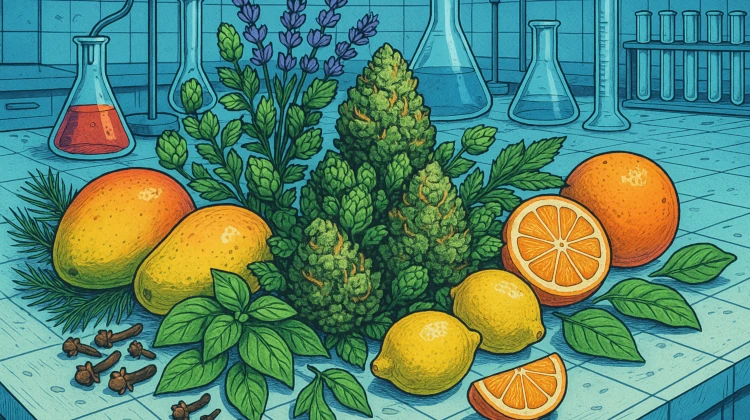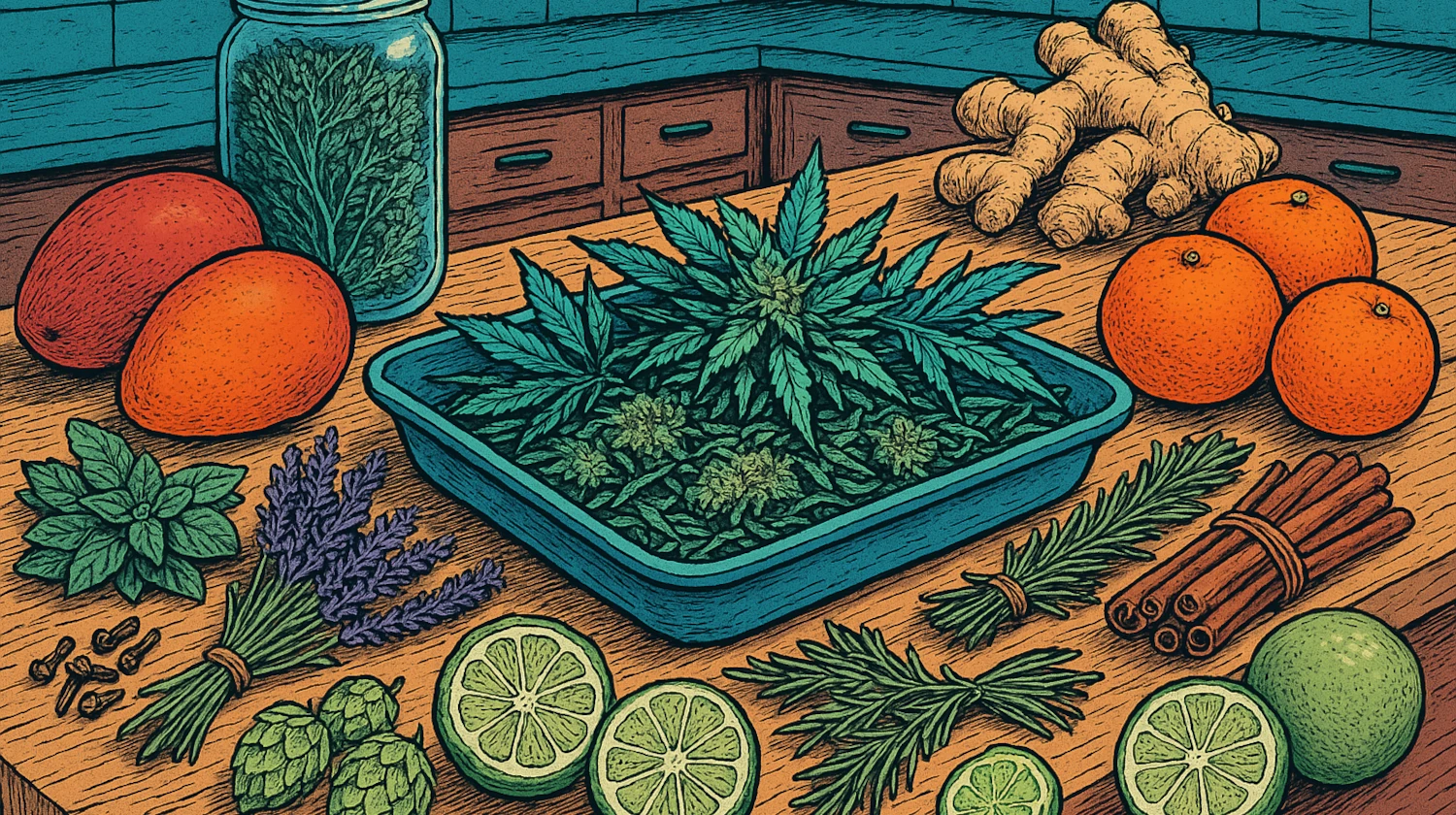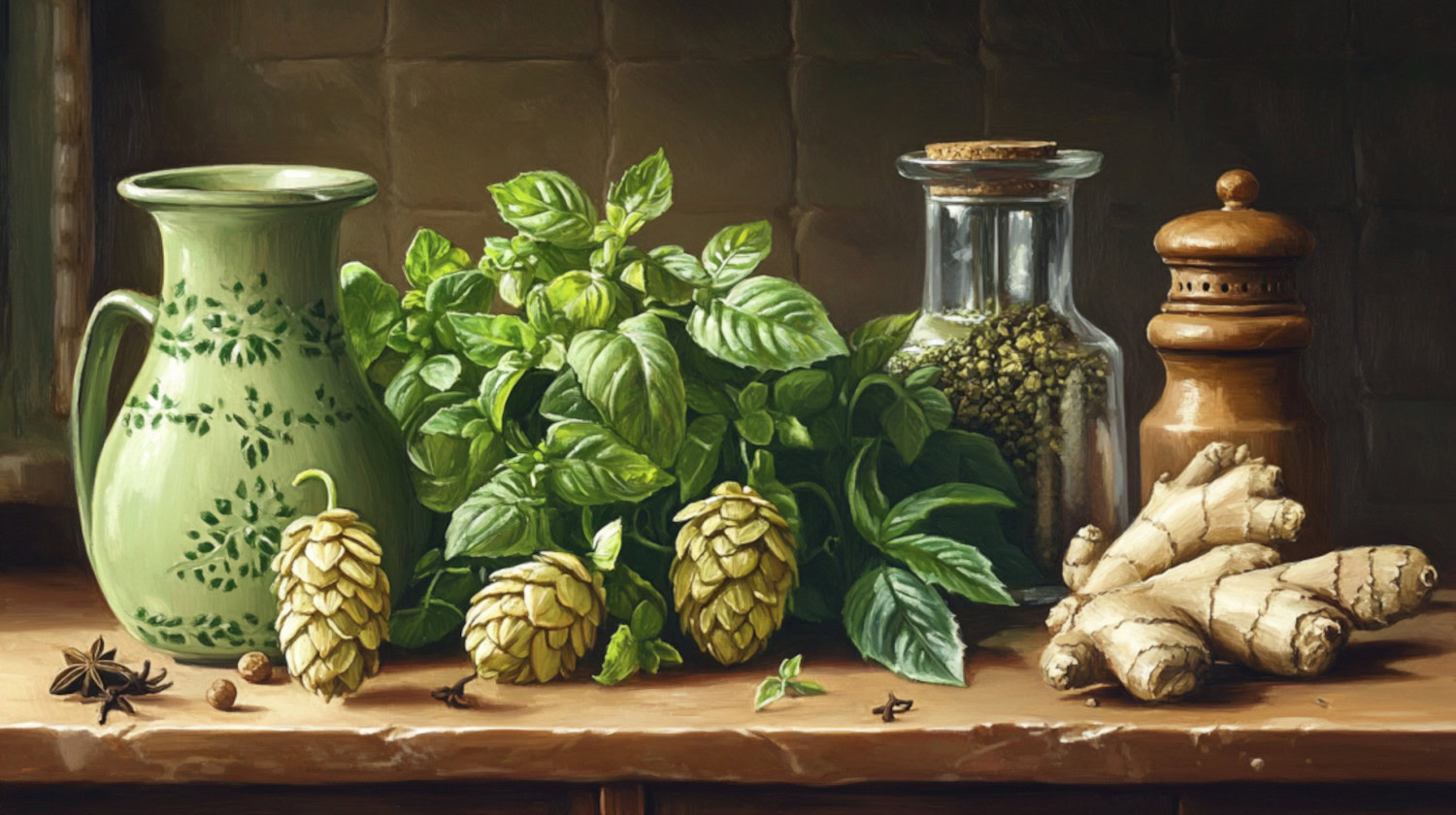In This Article
- What are Terpenes?
- Types of Terpenes
- Where They’re Found in the Plant
- Terpenes Beyond Cannabis
- What are the Common Cannabis Terpenes?
- Myrcene
- Caryophyllene
- Limonene
- Cannabis Terpene Chart: Effects, Applications, and Strains
- Do Terpenes Get You High by Themselves?
- What is the Difference Between Terpenes and Terpenoids?
- How Are Terpenes Different From CBD?
- How Do You Get the Most Terpenes When Growing?
- Can Terpenes Be Affected During Curing and Processing?
- How Do You Preserve Terpenes for Stored Cannabis?
- References
Key Takeaways About Cannabis Terpenes
- Terpenes are aromatic compounds found in plants that can influence flavor, aroma, and effects.
- Terpenes don’t get you high, but they may work with cannabinoids to shape your cannabis experience.
- Knowing a strain’s terpene profile may help you better understand its effects, but more research is still needed.
Like flower and wine varieties, each cannabis strain has a distinct aroma. Some smell like a citrus grove after the rain; others hit your nose like a pine forest or funky gas station. A cannabis terpene chart like the one below can help to clue you in on what you may experience from a strain, based on its terpenes.
What are Terpenes?

Terpenes are the aromatic compounds that give cannabis (and most other plants) their distinct smell. They’re found in the essential oils of herbs, fruits, and flowers. In cannabis, they’re concentrated in the tiny, crystal-like trichomes that coat the buds.
Types of Terpenes
Terpenes can be grouped by their structure:1
- Monoterpenes (myrcene, limonene, phellandrene)
- Sesquiterpenes (pinene, humulene, farnesene)
- Monoterpenoids (linalool, geraniol, cineole)
- Sesquiterpenoids (bisabolol)
Many researchers think terpenes work hand-in-hand with cannabinoids and other molecules to shape the cannabis experience. This synergy is often referred to as the entourage effect.
Still, it’s important to note that most terpene studies are in the early stages and often focus on single compounds in isolation, rather than the entire plant.
Where They’re Found in the Plant
- Monoterpenes tend to cluster in the stalked trichomes of cannabis buds.
- Sesquiterpenes are more common in the sessile trichomes of sugar leaves.2
Terpenes Beyond Cannabis
Cannabis may have popularized terpene talk, but these compounds are everywhere:
- Valencene gives Valencia oranges their signature scent. It's also being studied for antioxidant and anti-inflammatory potential.3
- Borneol, found in cinnamon, has been used for centuries in traditional Chinese medicine and is being studied for possible pain-relieving effects.4,5
- Eucalyptol (cineole) shows up in eucalyptus and rosemary and is widely used in wellness products.6
And it’s not just plants. Terpenes are added to everyday items, such as perfumes, cleaners, and bug repellents. If you’ve ever caught a whiff of pine-scented cleaner, you’ve already experienced pinene at work.
While terpenes help shape cannabis’s aroma, new research suggests that volatile sulfur compounds (VSCs) and other non-terpenoid VOCs may actually be the bigger players behind those loud, skunky scents.7
What are the Common Cannabis Terpenes?

Cannabis produces over 150 different terpenes, but only a handful, like myrcene, caryophyllene, limonene, and pinene, show up consistently in lab-tested strains. Most terpene research so far has been done on isolated compounds in much higher concentrations than you’d typically encounter in flower or extracts.
According to Medical News Today, the most common terpenes found in cannabis potentially have properties worth investigating:
Myrcene
The most abundant terpene in cannabis, myrcene, is also found in hops, lemongrass, and mango. Many cannabis consumers describe myrcene-rich strains as relaxing or sedating, especially at higher concentrations.8 Common strains include Granddaddy Purple, OG Kush, Jack Herer, and Sour Diesel.
Caryophyllene
Caryophyllene is spicy, woodsy, and unique because it can bind to the body’s CB2 receptors. Found in black pepper, cloves, oregano, and basil. Caryophyllene is being studied for its possible role in inflammation and gastrointestinal health, though findings are still developing.3,9 In cannabis, you’ll see it in strains like Zkittlez, Bubba Kush, GG4, and Blue Dream.
Limonene
Limonene is bright, citrusy, and easily recognizable due to its lemon-like aroma. Beyond cannabis, it’s common in citrus fruits, soaps, and perfumes. In lab studies, limonene has been explored for mood and digestive support, but more research is needed to understand its effects in cannabis use. Popular strains with limonene include Wedding Cake and Do-Si-Dos.2,10,11
Cannabis Terpene Chart: Effects, Applications, and Strains
Some brands offer consumers a list of the top terpenes in each product, known as the terpene profile. This profile, along with the cannabinoid content, can give users an idea of how the strain will interact with their body.
A terpene chart is a valuable supplement to help medical cannabis patients and recreational consumers understand terpenes and their possible effects on the body.
The following terpene chart provides an overview of how terpenes can impact your cannabis experience.

Do Terpenes Get You High by Themselves?
Nope. Terpenes aren’t what cause the intoxicating “high” from cannabis. They don’t activate the brain’s CB1 receptors the way THC does.
The one exception is beta-caryophyllene, which can bind to CB2 receptors, but it does not produce intoxication. Instead, CB2 activity is more often associated with processes such as inflammation and immune function.12
While terpenes won't get you high on their own, they do help to shape the cannabis experience.
What is the Difference Between Terpenes and Terpenoids?
The two words are often used interchangeably, but there’s a small distinction:
- Terpenes are simple hydrocarbons.
- Terpenoids are modified versions that form when plants dry or oxidize.
Both exist in cannabis and may contribute to aroma and potential effects, but research is still in early stages.
How Are Terpenes Different From CBD?
Terpenes and CBD are both non-intoxicating, but they work very differently in the body:
- CBD is a cannabinoid. It has no odor and interacts directly with the endocannabinoid system by binding to cannabinoid receptors.
- Terpenes are aromatic compounds that give plants their scent and may help guide cannabis’s effects. They interact with a variety of receptors throughout the body and generally don't interact with the endocannabinoid system. The exception is beta-caryophyllene, which is unique in binding to the CB2 receptor, much like CBD.12
Both terpenes and cannabinoids, like CBD, are found in cannabis, but they interact with the body differently.
How Do You Get the Most Terpenes When Growing?

The terpene content of each strain or cultivar can vary from grow to grow. Several factors can impact terpenes, including:
- The quality of the genetics,
- Soil type and quality,
- Lighting,
- Whether or not plants are flushed,
- Harvest time,
- And post-harvest care, including cure and trim.
Can Terpenes Be Affected During Curing and Processing?
Yes. Terpenes live in the trichomes, which are the sticky, crystal-like structures on cannabis buds. They’re delicate. During drying and curing, terpenes can evaporate or degrade.
Processing can cause even more loss, depending on the method:
- Distillate: Strips away nearly everything, including terpenes, leaving mostly THC.
- Live Resin: Extracted from fresh, frozen flowers, preserving more of the plant’s natural terpene profile.
- Solventless Extractions: Methods like rosin pressing aim to keep both cannabinoids and terpenes intact.
If you care about flavor and aroma, products made with terpene-preserving methods (like live resin or solventless) are worth seeking out.
How Do You Preserve Terpenes for Stored Cannabis?
Even after purchase, how you store your flower makes a big difference. Terpenes are volatile. They break down when exposed to air, heat, and light. To keep them around longer:
- Check the date. Check the harvest and packaging dates before making a purchase. Cannabis can sit on shelves for months, and older flower often loses terpene content.
- Protect from the elements. Store in airtight, UV-protected jars. Avoid too much air, moisture, or light.
- Use humidity packs. These small packets help maintain the ideal moisture level in your jar.
- Grind only what you need. Grinding increases exposure to air, which speeds up terpene loss.
Think of it like keeping coffee beans fresh. Proper storage keeps the flavor, aroma, and overall experience intact.
References
- Masyita A, Mustika Sari R, Dwi Astuti A, et al. Terpenes and terpenoids as main bioactive compounds of essential oils, their roles in human health and potential application as natural food preservatives. Food Chem X. 2022;13:100217. Published 2022 Jan 19. doi:10.1016/j.fochx.2022.100217 ↩︎
- Sommano SR, Chittasupho C, Ruksiriwanich W, Jantrawut P. The Cannabis Terpenes. Molecules. 2020;25(24):5792. Published 2020 Dec 8. doi:10.3390/molecules25245792 ↩︎
- Zhang LL, Chen Y, Li ZJ, Fan G, Li X. Production, Function, and Applications of the Sesquiterpenes Valencene and Nootkatone: a Comprehensive Review. J Agric Food Chem. 2023;71(1):121-142. doi:10.1021/acs.jafc.2c07543 ↩︎
- Wang S, Zhang D, Jinsheng H, et al. A clinical and mechanistic study of topical borneol‐induced analgesia. Embo Molecular Medicine. 2017;9(6):802-815. doi:https://doi.org/10.15252/emmm.201607300 ↩︎
- Zhang QL, Fu BM, Zhang ZJ. Borneol, a novel agent that improves central nervous system drug delivery by enhancing blood-brain barrier permeability. Drug Deliv. 2017;24(1):1037-1044. doi:10.1080/10717544.2017.1346002 ↩︎
- Hoch CC, Petry J, Griesbaum L, et al. 1,8-cineole (eucalyptol): A versatile phytochemical with therapeutic applications across multiple diseases. Biomedicine & Pharmacotherapy. 2023;167:115467-115467. doi:https://doi.org/10.1016/j.biopha.2023.115467 ↩︎
- Paryani TR, Sosa ME, Michael, et al. Nonterpenoid Chemical Diversity of Cannabis Phenotypes Predicts Differentiated Aroma Characteristics. ACS omega. Published online June 19, 2024. doi:https://doi.org/10.1021/acsomega.4c03225 ↩︎
- Surendran S, Qassadi F, Surendran G, Lilley D, Heinrich M. Myrcene—What Are the Potential Health Benefits of This Flavouring and Aroma Agent? Frontiers in Nutrition. 2021;8. doi:https://doi.org/10.3389/fnut.2021.699666 ↩︎
- Shim HI, Song DJ, Shin CM, et al. Inhibitory Effects of β-caryophyllene on Helicobacter pylori Infection: A Randomized Double-blind, Placebo-controlled Study. Korean J Gastroenterol. 2019;74(4):199-204. doi:10.4166/kjg.2019.74.4.199 ↩︎
- Yavari Kia P, Safajou F, Shahnazi M, Nazemiyeh H. The effect of lemon inhalation aromatherapy on nausea and vomiting of pregnancy: a double-blinded, randomized, controlled clinical trial. Iran Red Crescent Med J. 2014;16(3):e14360. doi:10.5812/ircmj.14360 ↩︎
- Liktor-Busa E, Keresztes A, LaVigne J, Streicher JM, Largent-Milnes TM. Analgesic Potential of Terpenes Derived from Cannabis sativa. Pharmacological Reviews. 2021;73(4):98-126. doi:https://doi.org/10.1124/pharmrev.120.000046 ↩︎
- Cavalli J, Dutra RC. A closer look at cannabimimetic terpenes, polyphenols, and flavonoids: a promising road forward. Neural Regen Res. 2021;16(7):1433-1435. doi:10.4103/1673-5374.301011 ↩︎
The information in this article and any included images or charts are for educational purposes only. This information is neither a substitute for, nor does it replace, professional legal advice or medical advice, diagnosis, or treatment. If you have any concerns or questions about laws, regulations, or your health, you should always consult with an attorney, physician or other licensed professional.




